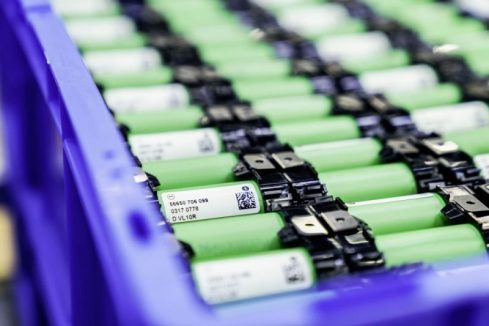The lithium-ion batteries in electric vehicles (EVs) present very different material demands at the cell- and pack-level compared with the internal-combustion engine (ICE) vehicles they replace. Whilst ICE drivetrains heavily rely on aluminum and steel alloys, Li-ion batteries utilize a lot of materials such as nickel, cobalt, lithium, copper, insulation, thermal interface materials, and much more at a cell- and pack-level. The markets for these materials will see a rapid increase in demand that would not have been present without the take-off of electric vehicle markets.
The new report from IDTechEx, “Materials for Electric Vehicle Battery Cells and Packs 2021-2031”, identifies and analyzes trends in the materials used for the assembly and production of battery cells and battery packs in the EV market. The report also provides granular market forecasts for over 20 key material categories in terms of demand in tonnes in addition to market value.
Improvements to energy density drive several materials market share. Source: IDTechEx, “Materials for EV Battery Cells and Packs 2021-2031” (www.IDTechEx.com/EVBattMat)
Battery Cell Materials
OEMs are changing the way they make batteries. Improvements to energy density are one key consideration but also the sustainability of the materials used. Many materials involved have questionable mining practices or volatile supply chains. One such material is cobalt, which in addition to being very expensive, has its supply and mining confined mostly to China and the Democratic Republic of Congo. As a result, OEMs are trending towards higher nickel cathode chemistries like NMC 622 or NMC 811 in some new models.
Up until 2018, the Chinese electric car market was predominately using LFP cathodes. This has now transitioned such that, as of 2019, only 3 % of cars utilized LFP batteries. However, Tesla has now introduced the LFP Model 3 made in China, which could upset this trend. Additionally, LFP is used extensively for markets like Chinese electric buses. Despite the reduction in market share of materials like cobalt, the rapidly increasing market for electric vehicles will drive demand for cobalt and many other materials drastically higher over the next 10 years.
Battery Pack Materials
Whilst the energy density improvements of Li-ion cells might be the most prominent battery improvements in the public eye, we are also seeing an increase in pack-level energy density at a greater rate than just cell-level improvements. Manufacturers are improving their battery designs; the mass of materials being used around the cells is steadily being reduced, allowing for a lighter battery pack or more cells to be used for the same mass. The choice of materials for several pack components also affects these improvements. More interest is being paid to composite enclosures for light-weighting, fire-retardant materials, thermal interface materials, and much more. The thermal management strategy also impacts these choices; with increased energy density and consumer demand for fast charging, thermal management has to be more effective but also present a smaller and lighter package. Several materials see a decrease in utilization per vehicle, but this is often overshadowed by the rapidly growing market for EVs.
Over 160 BEV & PHEV models are analyzed for energy density and thermal management. Full data is available in the IDTechEx report “Materials for EV Battery Cells and Packs 2021-2031” (www.IDTechEx.com/EVBattMat)
In the report “Materials for EV Battery Cells and Packs 2021-2031”, an extensive database collated by IDTechEx of over 300 battery-electric and plug-in hybrid passenger car variants is used to determine trends in the battery cell and pack energy density, energy capacity, cell geometry, cell chemistry, and thermal management strategy, leading to a comprehensive set of material demands and market value forecasts.
For more information on this report, please visit www.IDTechEx.com/EVBattMat. This report forms part of the broader electric vehicle and energy storage research from IDTechEx, who track the adoption of electric vehicles, battery trends, and demand across more than 100 different mobility sectors. This is summarized in a master report: www.IDTechEx.com/EV, or for further in-depth analysis, please see the full portfolio of electric vehicle research available from IDTechEx: www.IDTechEx.com/research/EV, including a report on the materials for electric motors.
About IDTechEx
IDTechEx guides your strategic business decisions through its Research, Subscription and Consultancy products, helping you profit from emerging technologies. For more information, contact research@IDTechEx.com or visit www.IDTechEx.com.
Image download: https://www.dropbox.com/sh/bkpa7infio10jis/AACSEzcDKOX2vVKgSYf0zu-Na?dl=0
Media Contact:
Natalie Moreton
Digital Marketing Manager
press@IDTechEx.com
+44(0)1223 812300
Social Media Links:
Twitter: https://www.twitter.com/IDTechEx
LinkedIn: https://www.linkedin.com/company/idtechex/
Facebook: https://www.facebook.com/IDTechExResearch
Share your industry press now!
Are you a PR agency or sustainability-focused organization? Join the World of Renewables network FREE today and gain exclusive access to our platform to promote your business, share the latest industry news, and connect with a global audience of 700,000+ renewable energy professionals.
Register Now to start posting your updates and showcase your expertise to a highly engaged, environmentally-conscious community.
Find out more about our Content Partnership Programs.*2024 AWARD WINNER* Websites & Mobile Sites, Webby Winner, Peoples Voice 2024














